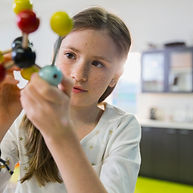OUTREACH
In addition to research, members of our lab are committed to equity, inclusion, and outreach in STEM. To this end, we are involved in a number of public outreach and engagement programs, both in NYC and Connecticut.



Early exposure to Science, Technology, Engineering and Mathematics (STEM) is one of the greatest predictors of STEM pursuit in post-secondary studies (Wang, 2013). Initiatives targeting students’ skills and interest in STEM careers are important for fostering interest in STEM, particularly among women and ethnic minority-groups, who remain underrepresented in STEM fields (National Center for Education Statistics, 2016). While collaborative STEM initiatives engage schools, educators, policy-makers, scientists, and researchers, many focus on students at high-school level, at which point attitudes towards, and interest in, STEM and STEM fields have largely been formed (Daugherty & Carter, 2018; DeJarnette, 2012). A focus on STEM experiences at the elementary (K-5) level instead would center on elementary school as the catalyst of STEM interest for most college majors (DeJarnette, 2012; Maltese et al., 2014).
While access to STEM activities is vital, an ever-growing body of evidence shows that students from underrepresented demographic groups feel less certainty about their abilities and presence in their academic field (Ito & McPherson, 2018; Zaniewski & Reinholz, 2016). Representative mentorship thus plays a key role in STEM pursuit from high-school to post-graduate level. (Kricorian et al., 2020). Seeing oneself represented in STEM contributes to the degree to which a student perceives STEM to be a key component of their sense of self (Kim et al., 2018; Robnett et al., 2018).
To foster early interest in STEM, members of PMEL, in collaboration with Dr. Anna Brady (Quinnipiac), initiated the ‘Scientists Like Us’ STEM Speaker Series, where we invite diverse voices from STEM fields to share their paths toward becoming practitioners in the STEM sciences with students at Hart Magnet Elementary, an Hispanic-Serving Title I elementary school in Stamford, CT. Speakers share when and how they first became interested in STEM; the steps they took toward achieving their goals; and the role their interest in STEM has played in their current and future career choices during 30-45 minute school-wide assemblies. Through these assemblies, our goal is to expose young students to the diversity of STEM jobs and STEM practitioners, and demonstrate that anyone can become a scientist, including themselves.
Our inaugural speaker in spring 2023, Ms. Stacy-Anne Parke, NYU graduate student (left), shared her interest in and path toward earning a PhD in Biological Anthropology. Since then, we have hosted an additional two speakers and have several lined-up for the spring 2024.
A list of our speakers and their fields of expertise from across the STEM disciplines can be found here.
For more information or to participate in our series, please reach out here.
HART MAGNET ELEMENTARY SCHOOLYARD HABITAT
Interaction with green spaces has demonstrable benefits to human health & well-being (reviewed in Twohig-Bennett & Jones 2021). In elementary-aged children, specifically, increased exposure to nature significantly reduces levels of anxiety and depression (Rian & Coll 2021). Moreover, early childhood exposure to green spaces can foster a lifelong connection to nature and environmentalism. “Specifically, childhood participation in “wild” nature such as hiking or playing in the woods, camping, and hunting or fishing, as well as participation with “domesticated” nature such as picking flowers or produce, planting trees or seeds, and caring for plants in childhood have a positive relationship to adult environmental attitudes” (Wells & Lekies 2006).
Unfortunately, within cities, green space is not always equitably distributed. Communities living in urban environments, particularly those of lower socioeconomic status, tend to be more limited in their access to green spaces and, by extension, their opportunities to interact with wildlife in natural environments (Byrne et al. 2009; McConnachie & Shackleton, 2010; Astell-Burt et al., 2014; Twohig-Bennett & Jones 2021).
In collaboration with the Hart Magnet PTO, members of our lab secured funding, donations, and volunteers to help bring green spaces to Hart Magnet Elementary School. Together, we worked to revitalize Hart’s Schoolyard Habitat, which included removing invasive species; planting sun-loving native shrubs, vines, grasses and wildflowers in the upper-level spaces of our Outdoor Classroom; installing structures (e.g., food and water sources) that will help attract native birds and butterflies to our habitat; and producing educational materials for Hart students.


CURRICULUM DEVELOPMENT
To complement activities in Hart's schoolyard habitat and engage students in hands-on scientific inquiry, members of PMEL are collaborating with teachers at Hart to design & implement science curricula that meet Next Generation Science Standards & align with Hart grade-level 'themes.' We are currently piloting curriculum for K & 2, and finalizing curricula for 1. Teaching materials resulting from these efforts will be made freely available here upon completion.

Kindergarten
Zoology -- Coming Winter 2023

3rd Grade
Stay tuned
1st Grade
Biology

2nd Grade
Botany -- Coming Winter 2023

4th Grade
Stay tuned

